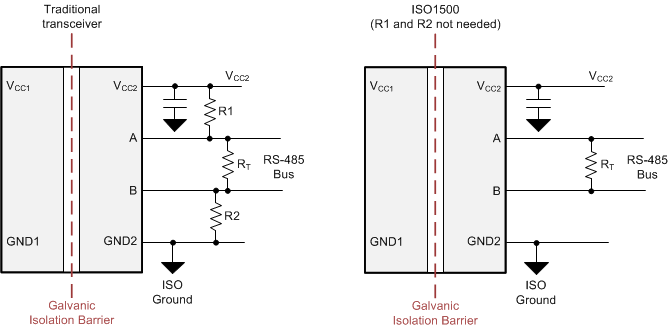SLLSF21D September 2018 – February 2020 ISO1500
PRODUCTION DATA.
- 1 Features
- 2 Applications
- 3 Description
- 4 Revision History
- 5 Pin Configuration and Functions
-
6 Specifications
- 6.1 Absolute Maximum Ratings
- 6.2 ESD Ratings
- 6.3 Recommended Operating Conditions
- 6.4 Thermal Information
- 6.5 Power Ratings
- 6.6 Insulation Specifications
- 6.7 Safety-Related Certifications
- 6.8 Safety Limiting Values
- 6.9 Electrical Characteristics: Driver
- 6.10 Electrical Characteristics: Receiver
- 6.11 Supply Current Characteristics: Side 1(ICC1)
- 6.12 Supply Current Characteristics: Side 2(ICC2)
- 6.13 Switching Characteristics: Driver
- 6.14 Switching Characteristics: Receiver
- 6.15 Insulation Characteristics Curves
- 6.16 Typical Characteristics
- 7 Parameter Measurement Information
- 8 Detailed Description
- 9 Application and Implementation
- 10Power Supply Recommendations
- 11Layout
- 12Device and Documentation Support
- 13Mechanical, Packaging, and Orderable Information
Package Options
Mechanical Data (Package|Pins)
- DBQ|16
Thermal pad, mechanical data (Package|Pins)
Orderable Information
8.3.2 Failsafe Receiver
The differential receiver of the ISO1500 device has failsafe protection from invalid bus states caused by:
- Open bus conditions such as a broken cable or a disconnected connector
- Shorted bus conditions such as insulation breakdown of a cable that shorts the twisted-pair
- Idle bus conditions that occur when no driver on the bus is actively driving
The differential input of the RS-485 receiver is 0 in any of these conditions for a terminated transmission line. The receiver outputs a failsafe logic-high state so that the output of the receiver is not indeterminate.
The receiver thresholds are offset in the receiver failsafe protection so that the indeterminate range of the input does not include a 0 V differential. The receiver output must generate a logic high when the differential input (VID) is greater than 200 mV to comply with the RS-485 standard. The receiver output must also generate a output a logic low when VID is less than –200 mV to comply with the RS-485 standard. The receiver parameters that determine the failsafe performance are VTH+, VTH–, and VHYS. Differential signals less than –200 mV always cause a low receiver output as shown in the Electrical Characteristics table. Differential signals greater than 200 mV always cause a high receiver output. A differential input signal that is near zero is still greater than the VTH+ threshold which makes the receiver output logic high. The receiver output goes to a low state only when the differential input decreases by VHYS to less than VTH+.
The internal failsafe biasing feature removes the need for the two external resistors that are typically required with traditional isolated RS-485 transceivers as shown in Figure 29.
 Figure 29. Failsafe Transceiver
Figure 29. Failsafe Transceiver